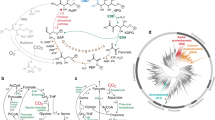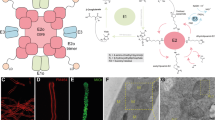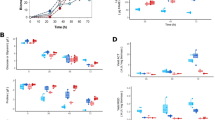Abstract
Sulphoquinovose (SQ, 6-deoxy-6-sulphoglucose) has been known for 50 years as the polar headgroup of the plant sulpholipid1,2 in the photosynthetic membranes of all higher plants, mosses, ferns, algae and most photosynthetic bacteria3. It is also found in some non-photosynthetic bacteria4, and SQ is part of the surface layer of some Archaea5. The estimated annual production of SQ4 is 10,000,000,000 tonnes (10 petagrams), thus it comprises a major portion of the organo-sulphur in nature, where SQ is degraded by bacteria6,7. However, despite evidence for at least three different degradative pathways in bacteria6,7,8, no enzymic reaction or gene in any pathway has been defined, although a sulphoglycolytic pathway has been proposed7. Here we show that Escherichia coli K-12, the most widely studied prokaryotic model organism, performs sulphoglycolysis, in addition to standard glycolysis. SQ is catabolised through four newly discovered reactions that we established using purified, heterologously expressed enzymes: SQ isomerase, 6-deoxy-6-sulphofructose (SF) kinase, 6-deoxy-6-sulphofructose-1-phosphate (SFP) aldolase, and 3-sulpholactaldehyde (SLA) reductase. The enzymes are encoded in a ten-gene cluster, which probably also encodes regulation, transport and degradation of the whole sulpholipid; the gene cluster is present in almost all (>91%) available E. coli genomes, and is widespread in Enterobacteriaceae. The pathway yields dihydroxyacetone phosphate (DHAP), which powers energy conservation and growth of E. coli, and the sulphonate product 2,3-dihydroxypropane-1-sulphonate (DHPS), which is excreted. DHPS is mineralized by other bacteria, thus closing the sulphur cycle within a bacterial community.
This is a preview of subscription content, access via your institution
Access options
Subscribe to this journal
Receive 51 print issues and online access
$199.00 per year
only $3.90 per issue
Buy this article
- Purchase on Springer Link
- Instant access to full article PDF
Prices may be subject to local taxes which are calculated during checkout



Similar content being viewed by others
References
Benson, A. A. The plant sulfolipid. Adv. Lipid Res. 1, 387–394 (1963)
Benning, C. Questions remaining in sulfolipid biosynthesis: a historical perspective. Photosynth. Res. 92, 199–203 (2007)
Benning, C. Biosynthesis and function of the sulfolipid sulfoquinovosyl diacylglycerol. Annu. Rev. Plant Physiol. Plant Mol. Biol. 49, 53–75 (1998)
Harwood, J. L. & Nicholls, R. G. The plant sulpholipid — a major component of the sulphur cycle. Biochem. Soc. Trans. 7, 440–447 (1979)
Meyer, B. H. et al. Sulfoquinovose synthase — an important enzyme in the N-glycosylation pathway of Sulfolobus acidocaldarius. Mol. Microbiol. 82, 1150–1163 (2011)
Martelli, H. L. Oxidation of sulphonic compounds by aquatic bacteria isolated from rivers of the Amazon region. Nature 216, 1238–1239 (1967)
Roy, A. B., Hewlins, M. J. E., Ellis, A. J., Harwood, J. L. & White, G. F. Glycolytic breakdown of sulfoquinovose in bacteria: a missing link in the sulfur cycle. Appl. Environ. Microbiol. 69, 6434–6441 (2003)
Denger, K., Huhn, T., Hollemeyer, K., Schleheck, D. & Cook, A. M. Sulfoquinovose degraded by pure cultures of bacteria with release of C3 organosulfonates: complete degradation in two-member communities. FEMS Microbiol. Lett. 328, 39–45 (2012)
Cook, A. M. Biodegradation of s-triazine xenobiotics. FEMS Microbiol. Rev. 46, 93–116 (1987)
Mayer, J. et al. 2,3-Dihydroxypropane-1-sulfonate degraded by Cupriavidus pinatubonensis JMP134: purification of dihydroxypropanesulfonate 3-dehydrogenase. Microbiology 156, 1556–1564 (2010)
Baba, T. et al. Construction of Escherichia coli K-12 in-frame, single-gene knockout mutants: the Keio collection. Mol. Syst. Biol. 2, 2006.0008 (2006)
Graham, D. E., Xu, H. & White, R. H. Identification of coenzyme M biosynthetic phosphosulfolactate synthase: a new family of sulfonate biosynthesizing enzymes. J. Biol. Chem. 277, 13421–13429 (2002)
Mampel, J. et al. A novel outer-membrane anion channel (porin) as part of the putatively two-component transport system for p-toluenesulfonate in Comamonas testosteroni T-2. Biochem. J. 383, 91–99 (2004)
Mayer, J. & Cook, A. M. Homotaurine metabolized to 3-sulfopropanoate in Cupriavidus necator H16: enzymes and genes in a patchwork pathway. J. Bacteriol. 191, 6052–6058 (2009)
Saito, N. et al. Metabolite profiling reveals YihU as a novel hydroxybutyrate dehydrogenase for alternative succinic semialdehyde metabolism in Escherichia coli. J. Biol. Chem. 284, 16442–16451 (2009)
Cornish-Bowden, A. Thermodynamic aspects of glycolysis. Biochem. Educ. 9, 133–137 (1981)
Sugimoto, K., Sato, N. & Tsuzuki, M. Utilization of a chloroplast membrane sulfolipid as a major internal sulfur source for protein synthesis in the early phase of sulfur starvation in Chlamydomonas reinhardti. FEBS Lett. 581, 4519–4522 (2007)
Cook, A. M. & Denger, K. Dissimilation of the C2 sulfonates. Arch. Microbiol. 179, 1–6 (2002)
Benson, A. A. & Shibuya, I. Sulfocarbohydrate metabolism. Fed. Proc. 20, 79 (1961)
Sato, Y. et al. Cupriavidus pinatubonensis sp. nov. and Cupriavidus laharis sp. nov., novel hydrogen-oxidizing, facultatively chemolithotrophic bacteria isolated from volcanic mudflow deposits from Mt. Pinatubo in the Philippines. Int. J. Syst. Evol. Microbiol. 56, 973–978 (2006)
Thurnheer, T., Köhler, T., Cook, A. M. & Leisinger, T. Orthanilic acid and analogues as carbon sources for bacteria: growth physiology and enzymic desulphonation. J. Gen. Microbiol. 132, 1215–1220 (1986)
Schmidt, A., Müller, N., Schink, B. & Schleheck, D. A proteomic view at the biochemistry of syntrophic butyrate oxidation in Syntrophomonas wolfei. PLoS ONE 8, e56905 (2013)
Laemmli, U. K. Cleavage of structural proteins during the assembly of the head of bacteriophage T4. Nature 227, 680–685 (1970)
Weiss, M., Denger, K., Huhn, T. & Schleheck, D. Two enzymes of a complete degradation pathway for linear alkylbenzenesulfonate (LAS) surfactants: 4-sulfoacetophenone Baeyer-Villiger monooxygenase and 4-sulfophenylacetate esterase in Comamonas testosteroni KF-1. Appl. Environ. Microbiol. 78, 8254–8263 (2012)
Felux, A.-K., Denger, K., Weiss, M. & Cook, A. M & Schleheck, D. Paracoccus denitrificans PD1222 utilizes hypotaurine via transamination followed by spontaneous desulfination to yield acetaldehyde, and finally acetate for growth. J. Bacteriol. 195, 2921–2930 (2013)
Kennedy, S. I. T. & Fewson, C. A. Enzymes of the mandelate pathway in bacterium N.C.I.B. 8250. Biochem. J. 107, 497–506 (1968)
Bradford, M. M. A rapid and sensitive method for the quantitation of microgram quantities of protein utilizing the principle of protein-dye binding. Anal. Biochem. 72, 248–254 (1976)
Sörbo, B. Sulfate: turbidimetric and nephelometric methods. Methods Enzymol. 143, 3–6 (1987)
Acknowledgements
We thank E. Deuerling for substrain MG1655, J. Klebensberger for substrain BW25113 and its knockout mutants, and K. Leitner for help with growth experiments. The work of M.W. and A.-K.F. was supported by the Konstanz Research School Chemical Biology (KoRS-CB), the work of C.M. by German Research Foundation (DFG) grants (MA2436/4 and SFB766/A15) and by the Baden-Württemberg Stiftung (P-BWS-Glyko11), and the work of D.Sc. by a DFG grant (SCHL 1936/1-1) and by the University of Konstanz and the Konstanz Young Scholar Fund.
Author information
Authors and Affiliations
Contributions
K.D. carried out most of the enzymic experiments, together with M.W. and A.-K.F., who carried out the heterologous expressions and RT–PCR. A.-K.F., A.S., C.M. and D.Sp. carried out the LC–MS analyses, and T.H. the chemical syntheses and NMR. D.Sc. set up the HILIC separation and carried out the 2D-PAGE, growth physiology and mutant analyses. A.M.C. and D.Sc. wrote the manuscript.
Corresponding authors
Ethics declarations
Competing interests
The authors declare no competing financial interests.
Extended data figures and tables
Extended Data Figure 1 Soluble proteins in glucose- or SQ-grown cells of E. coli K-12 MG1655 separated by 2D-PAGE.
All prominent protein spots on the gel from SQ-grown cells that suggested inducibly expressed proteins were excised and submitted to PF–MS (see Extended Data Table 1). The PF–MS identifications were replicated in an independent growth experiment and gel electrophoresis run.
Extended Data Figure 2 Differential transcriptional analysis of the genes encoding the central pathway of sulphoglycolysis in E. coli K-12.
RT–PCR of the inducible transcription of genes b3879 (epimerase), b3880 (isomerase), b3883 (kinase), b3881 (aldolase) and b3882 (reductase) in cells grown with SQ in comparison to glucose-grown cells. A positive control was a constitutively expressed gene (b0720; gltA, citrate synthase), and a negative control was a PCR without reverse transcription (RNA) to confirm the absence of DNA contamination in the RNA preparations used. The results were replicated starting from an independent growth experiment.
Extended Data Figure 3 Purity of heterologously expressed enzymes using SDS–PAGE.
M, marker proteins; 1, b3880 (isomerase); 2, b3883 (sugar kinase); 3, b3881 (aldolase); 4, b3882 (reductase). A representative SDS gel is shown (n = 2). Each enzyme, 20 µg.
Extended Data Figure 4 Separation of SQ, SF and analogues by HILIC–HPLC and detection by ESI–TOF–MS.
a, Extracted ion chromatogram of SQ in reaction buffer before (top) and after (bottom) addition of recombinant isomerase b3880 to generate SF. The exact masses determined for the [M-H]− ions of SQ and SF are indicated (in Da); the theoretical exact masses (monoisotopic masses) for the [M-H]− ions of both SQ and SF (each C6H11O8S−) is 243.0180 Da. The data from a representative experiment are shown; the results were replicated (n = 3) with samples from independent enzyme reactions. b, Samples of reference substances fructose and glucose (top), and fructose-6-phosphate and glucose-6-phosphate (bottom). The reference substances illustrate the chromatographic separation by HILIC; that is, the ketoses (for example, SF) elute before the aldoses (for example, SQ).
Extended Data Figure 5 MS–MS fragmentation of SQ and SF.
a, Fragment ions of the [M-H]− ions of SQ. b, Fragment ions of the [M-H]− ions of SF. The fragmentation pattern of both compounds, SQ and SF, is dominated by the loss of water (−18), C2H4O2 (−60), C3H6O3 (−90) and C4H8O4 (−120), and by the formation of HSO3− (81) ions. The MS–MS spectra of SQ and SF differ in their peak heights, in particular in their base peak for SQ (183) and of SF (153) corresponding to a preferred formation of C4H7O6S− and C3H5O5S−, respectively; both fragments might be formed by McLafferty-like rearrangement reactions corresponding to the different positions of the keto groups in SQ and SF. Representative data are shown (n = 5; see Fig. 3).
Extended Data Figure 6 MS–MS fragmentation of SFP and FBP.
a, Fragment ions of the [M-H]− ions of SFP. b, Fragment ions of the [M-H]− ions of the analogue fructose-1,6-bisphosphate (FBP) for comparison. Fragmentations led to loss of water (−18) and/or loss of phosphoric acid (−98), and to the formation of dihydrogen phosphate (97) and pyrophosphate (177). Representative data are shown (n = 5; see Fig. 3).
Extended Data Figure 7 MS–MS fragmentation of SLA and DHPS.
a, Fragment ions of the [M-H]− ions of SLA. b, Fragment ions of the [M-H]− ions of DHPS. Fragmentation of SLA led to a cleavage of the carbon-sulphur bond and formation of HSO3− (81) and [C3H3O2]− (71) ions. The fragmentation of DHPS is characterized by an initial loss of water (−18) and concomitant fragmentation of the enol (or the methylketone) to ketene (−42) and formation of [CH3O3S]− (95) ions; the same fragmentation pattern was observed for authentic DHPS standard (not shown). Representative data are shown (n = 5; see Fig. 3).
Extended Data Figure 8 Hypothetical degradation of the sulpholipid sulphoquinovosyl diacylglycerol in E. coli K-12.
Presumed functions of OmpL (b3875) and YihQ (b3878); apart from OmpL, the subcellular location of this pathway is unknown. R1 and R2 indicate acyl chains of different length and degree of unsaturation.
Rights and permissions
About this article
Cite this article
Denger, K., Weiss, M., Felux, AK. et al. Sulphoglycolysis in Escherichia coli K-12 closes a gap in the biogeochemical sulphur cycle. Nature 507, 114–117 (2014). https://doi.org/10.1038/nature12947
Received:
Accepted:
Published:
Issue Date:
DOI: https://doi.org/10.1038/nature12947
This article is cited by
-
Novel indole-mediated potassium ion import system confers a survival advantage to the Xanthomonadaceae family
The ISME Journal (2022)
-
Genome sequences of Arthrobacter spp. that use a modified sulfoglycolytic Embden–Meyerhof–Parnas pathway
Archives of Microbiology (2022)
-
Sulfoquinovose is a select nutrient of prominent bacteria and a source of hydrogen sulfide in the human gut
The ISME Journal (2021)
-
Sulfur metabolites in the pelagic ocean
Nature Reviews Microbiology (2019)
-
Sulfur metabolites that facilitate oceanic phytoplankton–bacteria carbon flux
The ISME Journal (2019)
Comments
By submitting a comment you agree to abide by our Terms and Community Guidelines. If you find something abusive or that does not comply with our terms or guidelines please flag it as inappropriate.



